


103d INFANTRY DIVISION WORLD WAR II ASSOCIATION

General Officers Serving with the 103d Infantry Division (CACTUS)
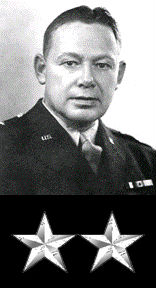 General Haffner came out of the Illinois National Guard when the 33d Infantry Division was federalized. At that time he was the commander of the 33d ID Div Arty. On August 13, 1942 General Haffner received his second star and assumed command of the 103d Infantry Division (Cactus) where he remained until health issues forced him to evacuate the war zone and into retirement.
General Haffner came out of the Illinois National Guard when the 33d Infantry Division was federalized. At that time he was the commander of the 33d ID Div Arty. On August 13, 1942 General Haffner received his second star and assumed command of the 103d Infantry Division (Cactus) where he remained until health issues forced him to evacuate the war zone and into retirement.
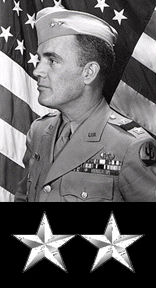 Brigadier General Anthony McAuliffe, served as Commanding General of the 101st Airborne Division in the absence of Major General Maxwell Taylor, who was attending a staff conference when the 101st became encircled at Bastogne. In the midst of the 101st Airborne's struggle at the Battle of the Bulge, the Germans issued a call for unconditional surrender. General McAuliffe sent a one word reply; "nuts." Afterwards, in December 1944, the weather cleared and the 101st Airborne Division was resupplied by air. The U.S. Army Air Corps, meanwhile, pounded the Germans relentlessly. After the victory at Bastogne, Brigadier General McAuliffe received command of the 103d Infantry Division (Cactus), replacing the ailing Major General Haffner. General McAuliffe remained as the Commanding General until the 103d Infantry Division's deactivation in September 1945. General McAuliffe remained in the Army, retiring as a full General.
Brigadier General Anthony McAuliffe, served as Commanding General of the 101st Airborne Division in the absence of Major General Maxwell Taylor, who was attending a staff conference when the 101st became encircled at Bastogne. In the midst of the 101st Airborne's struggle at the Battle of the Bulge, the Germans issued a call for unconditional surrender. General McAuliffe sent a one word reply; "nuts." Afterwards, in December 1944, the weather cleared and the 101st Airborne Division was resupplied by air. The U.S. Army Air Corps, meanwhile, pounded the Germans relentlessly. After the victory at Bastogne, Brigadier General McAuliffe received command of the 103d Infantry Division (Cactus), replacing the ailing Major General Haffner. General McAuliffe remained as the Commanding General until the 103d Infantry Division's deactivation in September 1945. General McAuliffe remained in the Army, retiring as a full General.
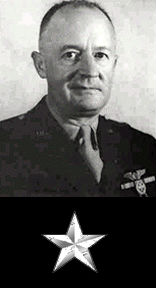 Brigadier General John T. Pierce served during WW I as a cavalry officer. He previously commanded the 14th Cavalry Regiment and 2nd Brigade, 1st Cavalry Division. General Pierce joined the 103d Infantry Division (Cactus) at Camp Claiborne, Louisiana and served as the Assistant Division Commander until the Division's deactivation in September 1945.
Brigadier General John T. Pierce served during WW I as a cavalry officer. He previously commanded the 14th Cavalry Regiment and 2nd Brigade, 1st Cavalry Division. General Pierce joined the 103d Infantry Division (Cactus) at Camp Claiborne, Louisiana and served as the Assistant Division Commander until the Division's deactivation in September 1945.
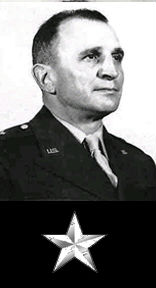 Brigadier General Roger M. Wicks graduated from the United States Military Academy (USMA) in November 1, 1918 and subsequently assigned to the European Theatre. After a six year stint overseas, he returned to the USMA as an instructor and backfield coach for the Army football team. Later he served as an instructor at the Army's Field Artillery School in Fort Sill, Oklahoma. General Wicks commanded the 79th Field Artillery Regiment at Fort Bragg, North Carolina and served as the Corps Artillery Officer, IV Army Corps. He was promoted to Colonel in July 1942. Then, in August 1942, Wicks became Division Artillery Commander of the Cactus Division and received his star on November 2, 1942. He served as Division Artillery Commander for the 103d Infantry Division until the unit's deactivation in September 1945.
Brigadier General Roger M. Wicks graduated from the United States Military Academy (USMA) in November 1, 1918 and subsequently assigned to the European Theatre. After a six year stint overseas, he returned to the USMA as an instructor and backfield coach for the Army football team. Later he served as an instructor at the Army's Field Artillery School in Fort Sill, Oklahoma. General Wicks commanded the 79th Field Artillery Regiment at Fort Bragg, North Carolina and served as the Corps Artillery Officer, IV Army Corps. He was promoted to Colonel in July 1942. Then, in August 1942, Wicks became Division Artillery Commander of the Cactus Division and received his star on November 2, 1942. He served as Division Artillery Commander for the 103d Infantry Division until the unit's deactivation in September 1945.
Senior Officers and Regimental Commanders

![]() Colonel Guy S. Meloy, Jr. replaced Colonel Lewis C. Barkes as Chief of Staff. A graduate of United States Military Academy, Colonel Meloy was one of the first Anti-Tank Officers in the U.S. Army. He served as the Cactus Division's Chief of Staff from April 1944 until the unit's deactivation in September 1945. Colonel Meloy continued his service with the Army, retiring in 1963 with the rank of General.
Colonel Guy S. Meloy, Jr. replaced Colonel Lewis C. Barkes as Chief of Staff. A graduate of United States Military Academy, Colonel Meloy was one of the first Anti-Tank Officers in the U.S. Army. He served as the Cactus Division's Chief of Staff from April 1944 until the unit's deactivation in September 1945. Colonel Meloy continued his service with the Army, retiring in 1963 with the rank of General.
![]()
 Colonel Charles N. Stevens was the 409th Infantry Regiment's first commander. He held this command until poor health forced him into retirement in early 1944. Colonel Stevens Executive Officer was Lieutenant Colonel Claudius L. Lloyd, who received promotion to Colonel and assumed command upon the departure of Colonel Stevens. Colonel Lloyd remained in command of the 409th Infantry Regiment until the 103d Infantry Division (Cactus) was deactivated in September 1945.
Colonel Charles N. Stevens was the 409th Infantry Regiment's first commander. He held this command until poor health forced him into retirement in early 1944. Colonel Stevens Executive Officer was Lieutenant Colonel Claudius L. Lloyd, who received promotion to Colonel and assumed command upon the departure of Colonel Stevens. Colonel Lloyd remained in command of the 409th Infantry Regiment until the 103d Infantry Division (Cactus) was deactivated in September 1945.
![]()
 The unit was activated on November 15, 1942. The first commander, coming from the 85th Division, joined the 410th Infantry Regiment in early October 1942. Shortly thereafter, additional officers arrived at Camp Claiborne, Louisiana where the 410th Infantry Regiment started training. Colonel Henry J. P. Harding commanded the 410th Infantry Regiment during its combat phase in the European Theater of Operations.
The unit was activated on November 15, 1942. The first commander, coming from the 85th Division, joined the 410th Infantry Regiment in early October 1942. Shortly thereafter, additional officers arrived at Camp Claiborne, Louisiana where the 410th Infantry Regiment started training. Colonel Henry J. P. Harding commanded the 410th Infantry Regiment during its combat phase in the European Theater of Operations.
![]()
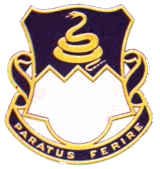 Regular Army officer, Colonel Donovan Yeuell commanded the 411th Infantry Regiment. His men viewed him as a no nonsense, hard charging commander who loved to be in the thick of things - whether when training or during operations. He gained men's respect for being a commander who would not send soldiers into areas where he personally would not go.
Regular Army officer, Colonel Donovan Yeuell commanded the 411th Infantry Regiment. His men viewed him as a no nonsense, hard charging commander who loved to be in the thick of things - whether when training or during operations. He gained men's respect for being a commander who would not send soldiers into areas where he personally would not go.
Dale Center for the Study of War & Society • School of Humanities-History• College of Arts & Sciences
The University of Southern Mississippi • 118 College Drive #5047 • Hattiesburg, MS • 39406
webmaster Dr. Kenneth Swope
